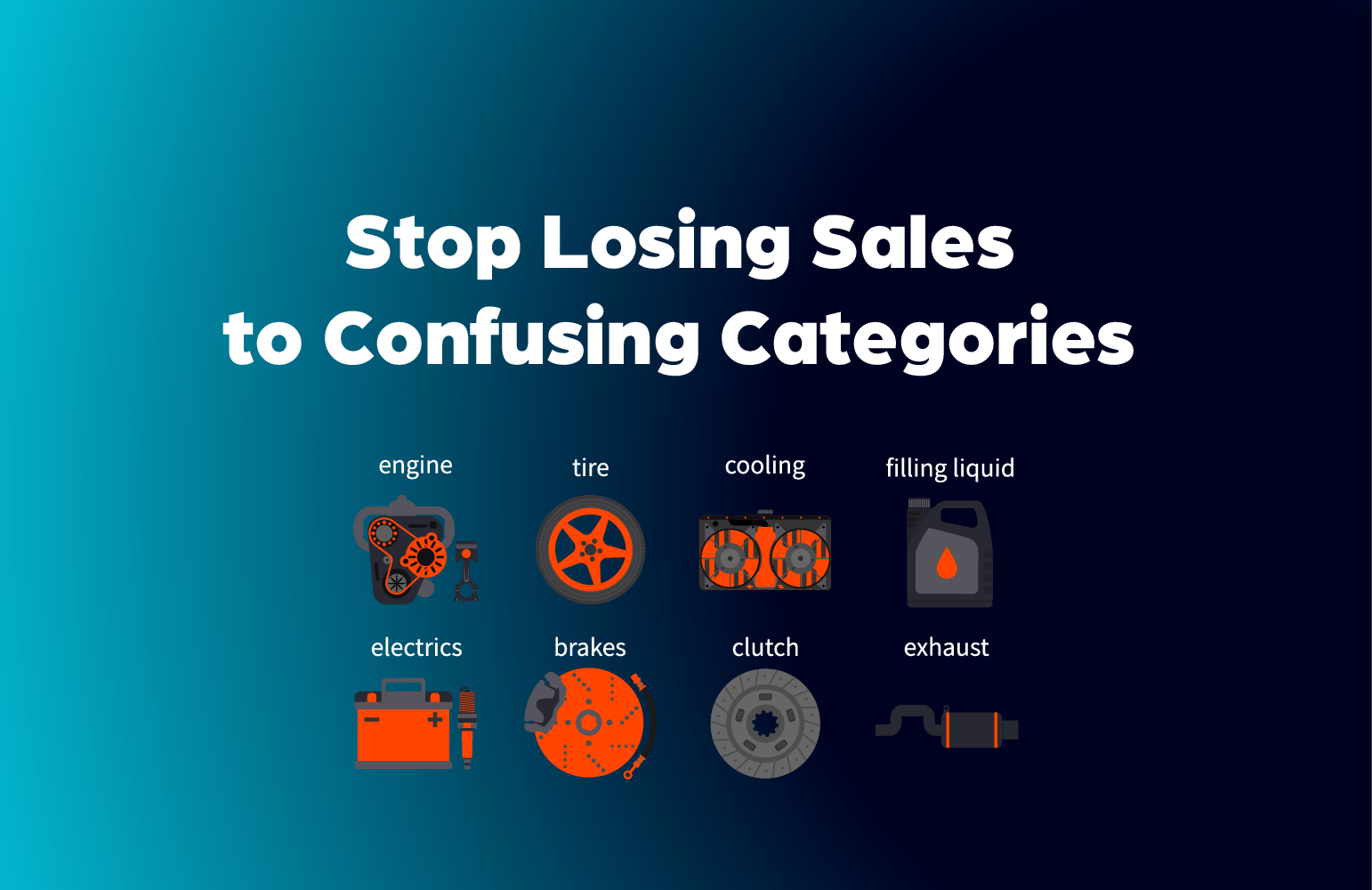If people can’t find the part they need, they won’t stick around — no matter how good your stock is.
We’ve all been there — you land on an auto parts site, and 10 seconds in, you’re already confused.
The categories don’t make sense, nothing feels intuitive, and suddenly it’s easier to just close the tab and start over somewhere else.
If you’re running an online store, you don’t want that to be your customer’s experience.
The truth is, most auto parts stores are structured the way suppliers or catalogs think — not the way people shop.
And that’s a problem.
In this guide, we’ll walk through how to organize your product categories in a way that actually works — for your customers, your team, and your sales.
1. Don’t copy your supplier’s categories blindly
We get it — when you’re importing thousands of parts from TecDoc, a wholesaler, or your own spreadsheet, it’s tempting to just use the categories they give you.
But supplier categories are made for logistics — not for people.
They’re often too technical, inconsistent, or broken into sections no buyer would naturally look for.
Instead, try to structure things around how your customers actually search:
- What problem are they trying to solve?
- What terms do they use?
- What vehicle do they drive?
Start simple: think function first (“Brakes,” “Filters”), or vehicle-first (“BMW > Brake Pads”).
The cleaner the structure, the easier it’ll be to navigate — and trust.
2. Speak human — not catalog
Nobody wants to scroll through a category called “Fastening Elements” or “Modules, Ignition System.”
That’s fine in a database. It’s terrible for ecommerce.
Make your categories sound like something a real customer would type or say:
- “Cabin Air Filters” instead of “Filter Insert – Internal”
- “Clips & Mounting Parts” instead of “Fastening Element”
- “Spark Plugs & Ignition Coils” instead of “Ignition Module”
Clear, human-first language builds trust. It also happens to be better for SEO.
3. Keep your top-level categories tight
When someone lands on your homepage, don’t hit them with 30 categories.
That much choice isn’t helpful — it’s overwhelming.
Stick to 5–8 high-level sections that feel familiar:
- Brakes
- Engine & Transmission
- Suspension & Steering
- Filters & Fluids
- Lighting & Electrical
- Body & Mirrors
- Tools & Accessories
Once someone clicks into one, you can get more specific — but first, just help them get their bearings.
4. Use subcategories — but don’t overdo it
Subcategories are great for helping users drill down. But don’t go wild with them.
Here’s the sweet spot:
- 3 to 5 subcategories under each main category
- Group things that really need separating (like “Brake Pads” vs. “Brake Discs”)
- Merge the ones that don’t (don’t split “Cabin Filters” and “Interior Air Filters” — it’s the same thing for most people)
Also: Don’t show subcategories with only one or two products. That just creates dead ends.
5. Make filters your best friend
Filters are life-saving for auto parts stores. Even if your categories are clean, buyers still need help narrowing things down.
These are the essentials:
- Vehicle: Make, Model, Year
- Brand
- Side/Position (Front, Rear, Left, Right)
- Fuel type / Transmission
- Stock or delivery time
You don’t need 20 filters. Just show the right ones at the right time — and make sure they actually work.
6. Separate universal parts from vehicle-specific ones
Some parts don’t need fitment logic. Don’t hide them where people won’t find them.
Things like:
- Motor oil
- Wipers
- Tools
- Floor mats
- Chargers & accessories
These can all live in a “Universal” or “Tools & Essentials” category — so buyers can browse them without worrying if they’ll fit a specific vehicle.
7. Use breadcrumbs + clean URLs
Breadcrumbs are those little links at the top of a page that show you where you are:
Home > Brakes > Brake Pads > BMW 3 Series (F30)
They help users go back a step, and they help Google understand your site structure — win-win.
Same for your URLs:
Keep them short, simple, and readable:
/brakes//brakes/discs//brakes/discs/bmw-3-series-f30/
No codes. No gibberish. Just clear paths.
8. Don’t duplicate listings just to place them in multiple categories
Let’s say you sell a set of brake pads that fits two car models.
You don’t need two separate listings.
Just make sure your product has:
- A complete compatibility section
- The right tags or collections to show up where it needs to
That way, you don’t end up with duplicate content, confusing pricing, or stock management nightmares.
Why this matters: If your store is hard to navigate, it doesn’t matter how good your prices are
Organizing your catalog isn’t just about being tidy — it’s about giving buyers confidence.
When your categories make sense, filters actually help, and pages don’t feel like a maze, people feel like they’re in the right place. They stay longer. They buy faster.
It’s one of the easiest ways to improve your store without touching your pricing or stock.
Final thoughts: Think like your customer, not your supplier
This one mindset shift can change your whole catalog:
“What would someone search for or expect to click on if they needed this part?”
If your categories reflect that — not some complicated supplier tree — everything gets easier: search, filters, returns, support, conversions.
And honestly? You’ll make your life easier too.
FAQs
Can I use the same structure as TecDoc or my main supplier?
You can use it to get started — but adapt it. Always clean up the names, remove clutter, and organize around your store’s customer journey.
How many category levels is too many?
Try to keep it to 2–3 levels deep. Anything beyond that becomes a maze.
What if a product fits multiple places?
Use tags, filters, or smart collections to display the same product in multiple sections — without creating duplicates.


